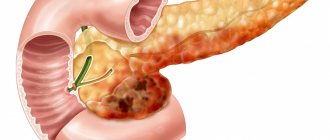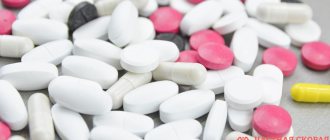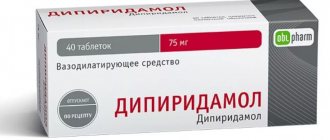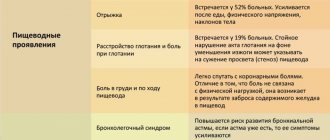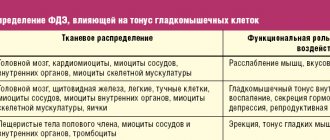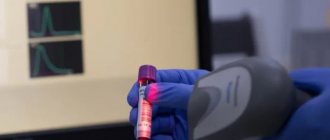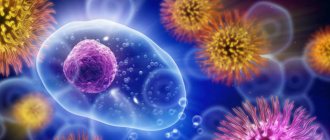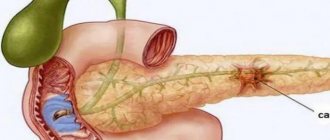Antienzyme drugs (proteolysis inhibitors) are a group of drugs that block the action of digestive pancreatic enzymes and are used to treat acute pancreatitis.
The pancreas is an organ of mixed secretion. Its endocrine part, which is represented by the islets of Langerhans, produces hormones directly into the blood that affect carbohydrate metabolism - insulin and glucagon. The exocrine part of the pancreas produces pancreatic juice, which is critically necessary for normal digestion, which is secreted through the duct into the lumen of the duodenum.
Pancreatic juice is a mixture of enzymes that can break down all the main components of food - proteins, fats and carbohydrates - into simple compounds that can be further absorbed in the small intestine.
Pancreatic enzymes (pancreatic enzymes) have extremely powerful “digestive” powers, so the pancreas synthesizes them in an initially inactive (zymogenic) form. Under normal conditions, the transition of pancreatic enzymes to an active form occurs only in the lumen of the duodenum, when interacting with food components.
In case of disruption of the outflow of pancreatic juice, for example, in acute diseases of the pancreas, enzymes are activated directly in the tissue of the gland itself. This, in turn, leads to so-called autolysis - “self-digestion” of the pancreas and enzymatic “melting” of surrounding tissues.
Autolysis of the pancreas is an acute condition that threatens human life. In the absence of adequate assistance measures, there is a high risk of death for the patient.
One of the basic groups of drugs that are used for the prevention and treatment of autolysis of the pancreas includes anti-enzyme drugs - proteolysis inhibitors.
Types of pancreatitis
In acute form of pancreatitis
a person experiences pain in the upper abdomen. Usually the pancreas hurts after fatty foods and alcohol. Pain in acute pancreatitis can be barely noticeable or severe (sometimes even radiating to the shoulder blade or chest). During an attack of acute pancreatitis, there may be nausea, vomiting, diarrhea, or constipation. The skin may turn yellow due to poor bile flow.
For chronic pancreatitis
pain in the upper abdomen, radiates to the back, left side of the chest, and lower abdomen. The pancreas hurts after fatty foods, alcohol or frequent stress. With chronic pancreatitis, nausea (sometimes vomiting), bloating, loss of appetite, and problems with stool (diarrhea or constipation) appear.
In chronic pancreatitis, periods of exacerbation alternate with periods of remission. If pancreatitis is not treated, exacerbations occur more often, intestinal disorders are observed, food ceases to be digested normally, and the person loses weight sharply.
Often, with chronic pancreatitis, various complications develop: bleeding in the stomach, abscesses and cysts, liver damage, enterocolitis, diabetes mellitus and even oncology. That is why, at the slightest problem with the pancreas, you need to consult a doctor as soon as possible.
Why does pancreatitis develop?
Pancreatitis begins when the tissue of the pancreas becomes inflamed. Causes of pancreatitis
- such:
- smoking and alcoholism;
- surgical operations and abdominal injuries;
- prolonged and uncontrolled use of certain medications (hormones, antibiotics, corticosteroids, some diuretics);
- food or chemical poisoning;
- heredity;
- poor nutrition (abundance of fatty and spicy foods, rare meals).
Diet features
What foods does the pancreas love?
If you have pancreatitis, you need to add more whole grains, fruits, vegetables and low-fat dairy products to your diet.
At the same time, you need to avoid eating fatty, fried, spicy foods and alcohol. It is also necessary to regularly monitor the condition of the digestive organs using various diagnostic methods.
Recommended Products:
- Fruits and berries: blueberries, cherries, grapes, plums, mangoes, apples, bananas and prunes.
- Vegetables: beets, broccoli, spinach, potatoes, cucumbers and carrots.
- Rice, buckwheat and lentils.
- Almonds, walnuts, pistachios and pumpkin seeds.
- Kefir, yogurt and yogurt.
- Eggs, beef and chicken.
- Products to avoid:
- Fatty types of red meat.
- Fried and spicy foods.
- Alcoholic drinks.
- Semi-finished meat products.
- Chips, crackers and other snacks.
- Mayonnaise.
- Margarine and vegetable oil.
- Fatty dairy products.
- Baked goods and foods with excess sugar.
Heavier foods, such as chicken, lentils and vegetables, are best for lunch. In the morning you need to eat porridge and fruit. The last meal should be no later than 6-8 pm.
Symptoms of pancreatitis
Symptoms of pancreatitis differ between acute and chronic forms.
Acute pancreatitis
has the following symptoms:
- Cutting, dull, constant and intense pain.
- Increased body temperature and pressure surges (can be both high and low). The reason is the rapid development of inflammation.
- The skin of the face becomes pale or yellowish.
- There is often nausea and vomiting, dry mouth, and a white coating on the tongue. With such symptoms, you need to fast so as not to worsen the situation.
- With pancreatitis, both diarrhea and constipation are possible. With diarrhea, the stool is often foamy, with particles of undigested food, and a foul odor. With constipation, the abdominal muscles are tense and bloating is felt (during an attack of pancreatitis, the intestines and stomach stop contracting).
- Shortness of breath, which occurs from dehydration when a person vomits frequently.
Chronic pancreatitis
has the following symptoms:
- The pain in the abdomen is either girdle, or in one point, but radiates to the back. The pancreas usually hurts immediately after eating.
- Poisoning of the body (intoxication) is expressed in general weakness, poor appetite, accelerated heartbeat, increased temperature, and decreased blood pressure.
- Endocrine problems – diabetes mellitus, risk of hypoglycemia and ketoacidosis. Red spots may appear on the skin of the abdomen, chest and back (if you press on them, they do not disappear).
If pancreatitis is not treated, a person begins to lose weight, develops anemia, vitamin deficiency, brittle hair and nails, and constant fatigue.
How to treat pancreatitis
In case of acute pancreatitis, the patient must be urgently hospitalized - this is a life-threatening condition, so self-medication is not acceptable here. Typically, antispasmodics are used to treat pancreas; if the case is serious, the contents of the stomach are pumped out to reduce the load on the pancreas. During the first week of hospital stay, the patient is monitored daily for blood counts, water balance, leukocyte and enzyme levels. In the first few days, a person will have to completely give up food and take alkaline solutions every two hours.
For chronic pancreatitis in the acute stage, the treatment regimen is the same as for acute pancreatitis. A person with chronic pancreatitis must adhere to a special diet all his life, take antispasmodics and pills to normalize the secretory ability of the pancreas. A diet for pancreatitis means avoiding fatty and fried foods.
Read also How to treat gastritis: 8 best drugs The best drugs for gastritis: reducing acidity, eliminating excess acid and fighting Helicobacter pylori.
Medicines for the treatment of pancreas
Everyone knows that when drinking alcohol, fatty and smoked foods, the pancreas suffers. The main symptom is pain, most often girdling, in the upper third of the abdomen, just below the ribs. Also, with diseases of the organ, nausea, vomiting appear, and stool becomes loose. In severe cases, complications from the lungs and heart occur.
Medicines for the pancreas should be prescribed by a doctor after examination. Only a specialist decides whether there is an acute process or whether these are symptoms of a chronic exacerbation. In the first case, to save life, mandatory hospitalization in the surgical department and injectable drugs are required, in the second, you can be treated at home.
Treatment of acute pancreatitis
The process with enlargement, swelling, and sometimes death of the gland area is treated with injectable drugs in the surgical department. Surgeons monitor the patient’s condition, monitor his blood and urine tests for the level of pancreatic enzymes. If necessary, surgical intervention is performed.
The following medications are used to treat the pancreas:
Antispasmodics
These are drugs that reduce or eliminate pain due to pancreatitis. They do this by eliminating spasm of the smooth muscles of the ducts through which the juice produced by the pancreas is excreted. To completely eliminate pain, these drugs often need to be combined with painkillers - non-steroidal anti-inflammatory drugs or even narcotic analgesics.
“Pure” antispasmodics include: No-shpa, Papaverine, Mebeverine, Buscopan.
Combined antispasmodics - drugs for the treatment of the pancreas - are: Baralgetas, Spazgan, Spazmalgon.
Anticholinergic drugs
These drugs reduce the production of pancreatic juice, which, together with the inflammatory exudate, increases the volume of fluid secreted through the ducts of the gland.
These include: Atropine, Platiphylline. When the process subsides, you can use combined antispasmodics, which also include anticholinergic (antisecretory) drugs: Spazgan, Spazmalgon.
Nonsteroidal anti-inflammatory drugs
They are aimed at reducing pain and inflammation. These are the names of drugs for the pancreas, such as Diclofenac, Ibuprofen. Along with them, to protect the stomach, be sure to take the following 2 groups of drugs.
Antacids
These are medications that, interacting with hydrochloric acid in gastric juice, neutralize it. This reduces the activity of the inflamed pancreas.
Antacids include Almagel, Phosphalugel, Maalox, Sekrepat.
Blockers of hydrochloric acid production
These medications are extremely necessary for the pancreas: a decrease in the production of hydrochloric acid by the stomach reflexively reduces the production of pancreatic juice, that is, the pancreas is given the opportunity to “rest” and recover.
2 groups of drugs inhibit the formation of HCl:
- histamine receptor blockers: Kvamatel, Rantak;
- proton pump inhibitors - a more modern type of drugs: Pantoprazole, Omeprazole, Rabeprazole, Nolpaza.
In acute pancreatitis, injectable forms of these drugs are administered.
Proteolytic enzyme inhibitors
You also cannot do without these drugs, since they effectively relieve swelling of the pancreas and reduce the degree of breakdown of the organ’s own tissues by enzymes. These drugs are administered intravenously by drip or intravenous micro-jet. These include: Kontrikal, Gordoks.
Hypothalamic hormones
This is the drug Sandostatin (Octreotide, Octrestatin), which will require from 1 to 5 ampoules per day, administered intravenously by drip or micro-jet. The essence of the hormone’s action is to inhibit the production of enzymes in the pancreas itself, as well as in the stomach and intestines, which can provoke additional work of the inflamed pancreas.
Remedies for nausea and vomiting
For nausea and vomiting, the following are used: Cerucal (Metoclopramide), Mosid. If the symptom is severe, the injection drug Osetron is prescribed at a dose of 2 to 16 mg per injection.
Diarrhea remedies
Frequent loose stools due to pancreatitis cannot be stopped with medication. You just need to replenish the electrolyte-rich fluid that is lost through bowel movements. This is done either orally - with solutions made from Regidon, Humana Electrolyte, Oralit, BioGaia ORS powders, or (if there is severe nausea or preparation for surgery) solutions of sodium chloride, glucose 5%, Ringer's, Acesol, Trisol are administered intravenously.
Antibacterial therapy
There is evidence that acute pancreatitis is of microbial (bacterial) origin. The following antibiotics are used to treat it (in some cases - 2 or 3 at once):
- Metronidazole;
- Ornidazole;
- Ceftriaxone;
- Ceftazidime;
- Augmentin;
- Levofloxacin;
- Ciprofloxacin.
Treatment of chronic pancreatitis
In the acute stage, that is, with the appearance of pain, nausea, diarrhea with the release of fatty stools, treatment is similar to therapy for an acute process, but taking tablet drugs is allowed (except for proteolytic enzyme blockers):
- Antispasmodics (preferably combined): Baralgetas, Spazmalgon;
- Proton pump blockers: Rabeprazole, Nolpaza, Contraloc;
- Antacids: Almagel, Maalox;
- Antiemetic (anti-nausea) agents: Mosid, Metoclopramide;
- Proteolysis inhibitors: Contrical, Gordox.
When the pain subsides, a medicine to restore the pancreas - an enzyme preparation - is added to treatment. The ideal option is a product that does not contain bile acids - Creon 8000 IU or 25000 IU. As an alternative, you can use Pancreatin, Wobenzym, Adzhizym, Ermital. Medicines are also used when the exacerbation subsides, with food. Course – up to 6-12 months.
Related products View all products
Almagel A, susp. for oral administration 170 ml No. 1
288,00 ₽
More details
Almagel Neo, susp. for oral administration 10 ml No. 10
253,00 ₽
More details
← Previous article Medicine for adenoma
Next article → Medicines for intestinal restoration
Pancreatin
The active ingredient in these pancreatic tablets is pancreatin. “Pancreatin” is an enzyme preparation that is prescribed not only for pancreatitis, but also for other diseases of the pancreas. Enzymes help digest food if the body does not have enough of its own enzymes. “Pancreatin” for the pancreas relieves heartburn, reduces heaviness in the stomach and relieves other unpleasant sensations. Patient reviews of the drug are good, although many doctors prefer to prescribe more expensive Pancreatin analogues, explaining this by their greater effectiveness.
Pancreatin
Tyumen Chemical Plant, Russia
Replacement therapy for exocrine pancreatic insufficiency: chronic pancreatitis, pancreatectomy, condition after irradiation, dyspepsia, cystic fibrosis.
Flatulence, diarrhea of non-infectious origin, Roemheld syndrome (gastrocardiac syndrome). Impaired digestion of food (condition after resection of the stomach and small intestine); to improve food digestion in people with normal gastrointestinal function in case of errors in nutrition (eating fatty foods, large amounts of food, irregular meals) and in cases of chewing dysfunction, sedentary lifestyle, prolonged immobilization. Preparation for x-ray and ultrasound examination of the abdominal organs. from 18
632
- Like
- Write a review
Causes of digestive disorders
Sometimes stomach problems begin after a heavy dinner or, conversely, after hunger. But besides these reasons, there are others that are associated with food consumption:
- Poor nutrition, namely abuse of smoked meats, pickles, fatty foods that are difficult to digest, as well as the presence of large quantities of sweets in the diet
- Binge eating. Doctors say that you need to leave the table half-starved, because with this feeling it is impossible to overeat. Often, the stomach is already full, but this signal has not reached the brain, and therefore the person thinks that he wants to eat. If you eat food slowly, you can avoid overeating, which can cause digestive problems.
- Poor chewing of food. Many people eat in a hurry and, because of this, chew food poorly, especially hard food. And it is much harder to digest
- Dinner at a late time. Many people are used to eating after 9 pm, which is very bad not only for the stomach, but also for the whole body. The biological clock works in such a way that by the evening all processes slow down, and late meals can simply lead to indigestion
- Drinking large amounts of water during meals. Almost all nutritionists recommend drinking a lot of water, but there is one caveat. This should be done exclusively between meals, as water dilutes the enzymes in the stomach and their action becomes less effective.
Everyone knows what causes digestive problems, but few people adhere to a healthy lifestyle, and with it, nutrition.
Mezim Forte
These tablets for the pancreas are relatively inexpensive, the active substance here is also pancreatin. Mezim Forte helps with poor pancreatic function and is prescribed for the treatment of pancreatitis. “Mezim” can be taken simply if you have overeaten or have a lot of fatty foods in your diet - the tablets help the pancreas cope with the increased load. Sometimes this drug is prescribed for a long course or on an ongoing basis. And although there are many more affordable drugs based on pancreatin, Mezim Forte is the one that is most often purchased.
Mezim Forte
Berlin-Chemie/Menarini, Germany
Insufficiency of exocrine pancreatic function (chronic pancreatitis, cystic fibrosis);
chronic inflammatory-dystrophic diseases of the stomach, intestines, liver, gall bladder. Conditions after resection or irradiation of these organs, accompanied by impaired digestion of food, flatulence, diarrhea (as part of combination therapy); to improve digestion of food in patients with normal gastrointestinal function in case of errors in nutrition; preparation for x-ray and ultrasound examination of the abdominal organs. from 48
703
- Like
- Write a review
Enzistal
“Enzistal” has a combined effect because, in addition to pancreatin, it contains ox bile extract and hemicellulose. Enzistal is prescribed for many diseases of the gastrointestinal tract, including inflammation of the pancreas. These tablets for pancreatitis improve the digestion of food, relieve pain, heaviness and any discomfort in the pancreas. "Enzistal" can be taken as a course, or it can be taken once when overeating. These tablets for pancreatitis have a special coating that dissolves in the small intestine - exactly where the remedy should work.
Enzistal
Torrent Pharmaceuticals, India
An enzyme preparation used for: Exocrine insufficiency of the pancreas, stomach, intestines, liver, gall bladder (chronic inflammatory-dystrophic diseases of these organs, condition after resection or irradiation);
flatulence, diarrhea of non-infectious origin; cystic fibrosis. To improve the digestion of food in persons with normal gastrointestinal function in case of errors in nutrition (eating fatty foods, large amounts of food, irregular meals); in case of disorders of chewing function (damage to teeth and gums, during the period of getting used to an artificial jaw); sedentary lifestyle; long-term immobilization. Preparation for X-ray examination and ultrasound of the abdominal organs. As an auxiliary drug for the rapid absorption of certain medications (PAS, sulfonamides, antibiotics). from 55
669
- Like
- Write a review
Creon 10,000
These are German capsules with small granules for the pancreas. In the stomach, the gelatin capsule dissolves and the granules are mixed with food. This action significantly increases the positive effect of the drug and reduces the load on the pancreas. You can buy Creon in a pharmacy with different dosages: 5000, 25,000 and 40,000. But only a doctor should tell you which dosage is suitable in your case. Many patients taking Creon note that this is the best drug based on pancreatin.
Creon
ABBOTT, France
Creon is a gelatin capsule consisting of mini-microspheres with pork pancreatin.
Gelatin capsules tend to dissolve quickly in the stomach, releasing microspheres that have an enteric coating and are easily mixed with gastric contents. After dissolution, Creon, together with the food bolus, enters the small intestine, where the shell of the microspheres dissolves and the active substance is released. from 231
5.0 1 review
1460
- Like
- Write a review
Forms of release of drugs
Not everyone knows that depending on how the drug is released, its immediate effect will depend. Today, all enzyme-based drugs are available in two forms:
- Capsules. More recently, drugs began to be produced in capsules, and for some time people were afraid to purchase them until the results of the study were publicly published. So, each capsule has all the shells. The first dissolves in the stomach, and the second only in the intestines. Thus, the effect of the drug taken in capsule form extends to the entire gastrointestinal tract
- Pills. It just so happens that consumers trust pills more. Their effect extends exclusively to the stomach, since under the influence of gastric juice it dissolves and is absorbed there.
The choice of the best form to take depends solely on the doctor and the patient. Some people, having purchased a capsule, for some reason open it and take only granules, thereby preventing the drug from penetrating the intestines. Under no circumstances should this be done with capsules. As for the tablets, they can be crushed, split into two parts, etc. This will not reduce the effect.
Buscopan
This drug for pancreatin is an antispasmodic, it is an analogue of “No-Shpa”, because it relieves spasm of the smooth muscles of internal organs. "Buscopan" perfectly relieves pain due to pancreatitis. Literally 15 minutes after taking the pill you will feel relief. Buscopan is extremely rarely prescribed as a course, because there is a possibility of side effects due to long-term use of antispasmodics. But a one-time effective remedy for pain in the pancreas is an ideal drug. Buscopan is very popular in America and Europe, but in our country it is not prescribed so often because of its high cost.
Buscopan
Boehringer Ingelheim, Germany
- spastic conditions of the gastrointestinal tract, biliary tract, genitourinary tract (including renal colic, biliary colic, intestinal colic, cholecystitis, pylorospasm);
- spastic dyskinesia of the biliary tract and gallbladder; - peptic ulcer of the stomach and duodenum in the acute phase (as part of complex therapy); - algodismenorrhea. ICD-10 code Indication K25 Gastric ulcer K26 Duodenal ulcer K31.3 Pylorospasm, not classified elsewhere K80 Gallstone disease [cholelithiasis] (including hepatic colic) K81.0 Acute cholecystitis K81.1 Chronic cholecystitis K82.8 Other specified diseases of the gallbladder and cystic duct (including dyskinesia) N23 Renal colic, unspecified N94.4 Primary dysmenorrhea N94.5 Secondary dysmenorrhea R10.4 Other and unspecified pain in the abdominal area (colic) from 268
834
- Like
- Write a review
Methods for diagnosing pancreatitis
The greatest difficulty is in diagnosing chronic pancreatitis.
.
Chronic pancreatitis often develops as an independent disease, and not as a complication of acute pancreatitis. At the same time, it is better to start treatment of chronic pancreatitis at an early stage, without leading to acute attacks.
For timely detection and diagnosis of chronic pancreatitis, it is necessary to undergo an annual preventive examination, as well as consult a gastroenterologist at the first suspicion of the disease.
The following diagnostic methods can be used to diagnose pancreatitis:
General blood analysis
A general blood test for pancreatitis reveals an increase in leukocytes (tens of times), a significant increase in ESR.
More information about the diagnostic method
Blood chemistry
In pancreatitis, the main indicator of biochemical analysis is pancreatic amylase (its level increases tenfold during the disease). An increase in other pancreatic enzymes, glucose and cholesterol is also expected.
More information about the diagnostic method
Biochemical urine analysis
In the case of pancreatitis, an increase in a biochemical urine test such as disstase (alpha-amylase) should be expected. The most indicative analysis of fresh urine (in CITO mode).
More information about the diagnostic method
Stool examination
For pancreatitis, a stool examination (coprogram) is performed. The study determines the degree of indigestion of food, as well as the ratio of digestive enzymes. Bacteria can be identified that have multiplied as a result of disruption of the intestines and the accumulation of food debris in it.
Ultrasound
Ultrasound of the pancreas allows you to confirm the diagnosis (detect an inflammatory process in the pancreas). Using ultrasound, you can evaluate the size of the pancreas, the condition of its tissue and ducts.
More information about the diagnostic method
X-ray of the abdominal cavity
X-rays can detect stones in the pancreas and its ducts. Currently, the preferred research method is computed tomography of the abdominal organs.
More information about the diagnostic method
MSCT of the abdominal cavity
Computed tomography of the abdominal cavity can identify complications of pancreatitis - such as stones, cysts and tumors (benign or malignant), and damage to neighboring organs.
More information about the diagnostic method
Magnetic resonance imaging (MRI)
MRI is the most informative method for examining the pancreas in cases of suspected pancreatitis. The method makes it possible to detect chronic pancreatitis in the early stages, even before the appearance of changes in soft tissues. Using MRI, differential diagnosis of chronic and acute pancreatitis is possible.
More information about the diagnostic method
Gastroscopy
Gastroscopy for pancreatitis makes it possible to assess the involvement of the stomach and duodenum in the pathological process. In some cases, gastroscopy can be used to determine what triggered the development of acute inflammation.
More information about the diagnostic method
Sign up for diagnostics To accurately diagnose the disease, make an appointment with specialists from the Family Doctor network.
Duspatalin
Another antispasmodic for relieving pain due to pancreatitis. Most often, Duspatalin is prescribed for irritable bowel syndrome, but the drug is also suitable for problems with the pancreas. Duspatalin has shown high effectiveness in chronic pancreatitis, but in acute pancreatitis it is rarely prescribed. These tablets (and capsules) perfectly relieve spasms, help if the pancreas hurts, dilate the ducts and improve the functioning of the duodenum. It should be borne in mind that Duspatalin tablets do not last as long as capsules with a prolonged effect.
Duspatalin
Abbott Laboratories, France
symptomatic treatment of pain, spasms, dysfunction and discomfort in the intestinal area associated with irritable bowel syndrome;
symptomatic treatment of spasms of the gastrointestinal tract, incl. caused by organic diseases. from 193
1214
- Like
- Write a review
Mezim
Pancreatin to improve digestion
Mezim is one of those drugs that is widely advertised in the media. One Mezim tablet consists of pancreatin, lipase, amylase and protease. In fact, the composition of Pancreatin tablets is the same. Mezim is prescribed in the following cases:
- Insufficient enzyme production
- For problems associated with food stagnation
- For inflammation of the gastric mucosa
- For chronic pancreatitis
Separately, it is necessary to say about the dosage. You should take one tablet (unless more is prescribed by your doctor) before each meal. Depending on what disease and what problem a person has, the course can last from several days to several months. It is strictly forbidden to take the drug if a person has intestinal obstruction, jaundice or hepatitis.
Mezim can be called a more expensive analogue of Pancreatin. The only thing that distinguishes them from each other is the taste. Most patients note that the coating covering the Mezim tablet is much sweeter and more pleasant than that of Pancreatin. And often, in order to give medicine to children, they buy Mezim.
Pariet
This Japanese drug is a proton pump inhibitor, that is, it reduces pancreatic secretion. The active substance of Parieta is rabeprazole. The product for the pancreas is not cheap, but, compared to cheaper analogues, it is much better and more effective. To improve the functioning of the pancreas, one tablet per day is enough. “Pariet” is most often prescribed for gastritis, but this drug also shows excellent results in the complex therapy of pancreatitis.
Pariet
Janssen-Cilag, UK
- gastric ulcer in the acute phase and anastomotic ulcer;
- duodenal ulcer in the acute phase; - erosive gastroesophageal reflux disease or reflux esophagitis; - maintenance therapy of gastroesophageal reflux disease; - non-erosive gastroesophageal reflux disease; - Zollinger-Ellison syndrome and other conditions characterized by pathological hypersecretion; - in combination with appropriate antibacterial therapy for the eradication of Helicobacter pylori in patients with peptic ulcer disease. from 566
978
- Like
- Write a review
Omez
Another inexpensive and popular proton pump inhibitor, the active substance of which is omeprazole. "Omez" greatly reduces the amount of hydrochloric acid in the stomach, thereby relieving the load on the pancreas. These tablets for pancreatitis reduce pain and relieve discomfort. Usually one tablet per day is enough. Relief occurs within an hour, and the effect of the drug lasts about a day. The price of Omez is average, and most patients with pancreatitis are satisfied with the results of treatment. Some gastroenterologists believe that Omez is a slightly outdated drug, but its effectiveness is beyond doubt.
Omez
Basics of treatment with antienzyme drugs
Considering the peculiarities and difficulties in selecting an individual dose of antienzyme drugs for a particular patient, as well as a wide range of side effects and interactions with other drugs, proteolysis inhibitors are prescribed only by an experienced doctor in a hospital setting.
Aprotinin can cause a severe allergic reaction, including anaphylactic shock. It is strictly contraindicated to prescribe the drug to patients who have been administered aprotinin over the past year.
